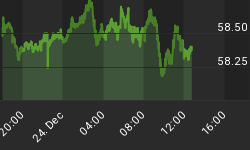Below is an extract from a commentary originally posted at www.speculative-investor.com on 9th September 2007.
With reference to the following daily chart of October gold futures, the close proximity to intermediate-term resistance at $710 and the fact that this resistance is being tested following a sharp 3-week rise are why we downgraded our short-term gold market outlook to "bearish" at the end of last week.
If the October contract closes at $715 or higher then our short-term outlook will change to either "neutral" or "bullish" because a decisive break above $710 will create a technical objective of $775. If an upside breakout occurs immediately (within the next few days) then the risk of a quick breakout failure will be quite high and we will only move our short-term view to "neutral". However, if gold can consolidate below $710 for at least a few days (preferably 1-2 weeks) before breaking above $710 then the upside breakout will have a greater chance of being sustained and we will move our short-term view to "bullish" in anticipation of a rise to $775.

Will an upside breakout in the gold market prevent the Fed from cutting its targeted interest rate on 18th September?
The Fed never likes to see substantial strength in the gold market, but notwithstanding all the entertaining theories to the contrary the central banks have very little direct control over the gold price. This is because the amount of gold that the CBs are capable of selling (or lending) into the market is very small compared to the amount of gold bullion that gets traded via the London Bullion Market Association (LBMA), and is of microscopic proportions compared to the amount of paper money sloshing around the world. Therefore, keeping the gold price under control involves the management of inflation expectations, which, in turn, involves such things as influencing short-term interest rates, controlling currency exchange rates, concocting bogus economic data, 'jawboning', etc.
The upshot is that if the markets decide that the gold price deserves to be higher then the gold price will go higher regardless of direct intervention by the Fed or any other central bank. It also means that if the Fed wants to halt a gold rally in its tracks it can really only do so via a significant tightening of monetary policy or by making the markets believe that monetary conditions are going to tighten.
Given that the financial markets have already discounted a near-term easing of monetary policy, if the Fed really wanted to it could probably halt the current gold rally by simply not cutting the Fed Funds rate at its 18th September meeting. However, we don't think the Fed will be concerned enough about the rising gold price to make it a top priority when deciding what actions to take over the next few weeks. The reason is that the current strength in the gold market is not occurring in response to rising inflation fears. If it were then the bond market would not be rallying with the gold market and the "Expected CPI" (the yield on the 10-year T-Note minus the yield on the inflation-protected 10-year T-Note) would not be near a 4-year low.
As far as we can tell, the current gold rally is being driven primarily by fears that the debt crisis will lead to a breakdown in the Dollar Index and secondarily by the contraction of liquidity. And unlike surging inflation fears, a breakdown in the Dollar Index would probably not concern the Fed at this time.
We therefore don't see the Fed as the main threat to the gold market's short-term upside prospects. The main threat is that the Dollar Index fails to do what just about everyone is expecting it to do and, instead, begins to trend upward.
















